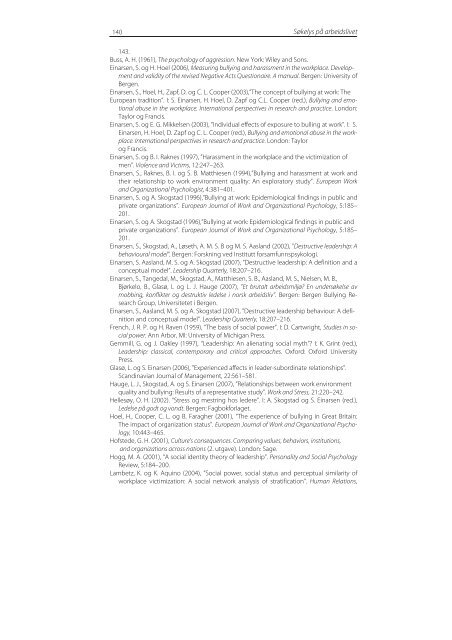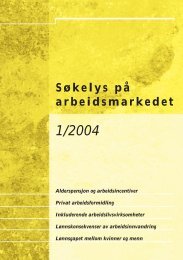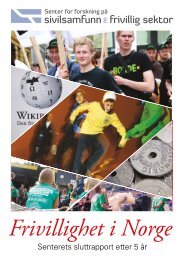I andre land betyr ikke hudfarge noe, har du papirer, så får du en jobb
I andre land betyr ikke hudfarge noe, har du papirer, så får du en jobb
I andre land betyr ikke hudfarge noe, har du papirer, så får du en jobb
Create successful ePaper yourself
Turn your PDF publications into a flip-book with our unique Google optimized e-Paper software.
140<br />
Søkelys på arbeidslivet<br />
143.<br />
Buss, A. H. (1961), The psychology of aggression. New York: Wiley and Sons.<br />
Einars<strong>en</strong>, S. og H. Hoel (2006), Measuring bullying and <strong>har</strong>assm<strong>en</strong>t in the workplace. Developm<strong>en</strong>t<br />
and validity of the revised Negative Acts Questionaire. A manual. Berg<strong>en</strong>: University of<br />
Berg<strong>en</strong>.<br />
Einars<strong>en</strong>, S., Hoel, H., Zapf, D. og C. L. Cooper (2003),”The concept of bullying at work: The<br />
European tradition”. I: S. Einars<strong>en</strong>, H. Hoel, D. Zapf og C.L. Cooper (red.), Bullying and emotional<br />
abuse in the workplace. International perspectives in research and practice. London:<br />
Taylor og Francis.<br />
Einars<strong>en</strong>, S. og E. G. M<strong>ikke</strong>ls<strong>en</strong> (2003), ”Indivi<strong>du</strong>al effects of exposure to bulling at work”. I: S.<br />
Einars<strong>en</strong>, H. Hoel, D. Zapf og C. L. Cooper (red.), Bullying and emotional abuse in the workplace.<br />
International perspectives in research and practice. London: Taylor<br />
og Francis.<br />
Einars<strong>en</strong>, S. og B. I. Raknes (1997), ”Harassm<strong>en</strong>t in the workplace and the victimization of<br />
m<strong>en</strong>”. Viol<strong>en</strong>ce and Victims, 12:247–263.<br />
Einars<strong>en</strong>, S., Raknes, B. I. og S. B. Matthies<strong>en</strong> (1994),”Bullying and <strong>har</strong>assm<strong>en</strong>t at work and<br />
their relationship to work <strong>en</strong>vironm<strong>en</strong>t quality: An exploratory study”. European Work<br />
and Organizational Psychologist, 4:381–401.<br />
Einars<strong>en</strong>, S. og A. Skogstad (1996),”Bullying at work: Epidemiological findings in public and<br />
private organizations”. European Journal of Work and Organizational Psychology, 5:185–<br />
201.<br />
Einars<strong>en</strong>, S. og A. Skogstad (1996),”Bullying at work: Epidemiological findings in public and<br />
private organizations”. European Journal of Work and Organizational Psychology, 5:185–<br />
201.<br />
Einars<strong>en</strong>, S., Skogstad, A., Løseth, A. M. S. B og M. S. Aas<strong>land</strong> (2002), ”Destructive leadership: A<br />
behavioural model”. Berg<strong>en</strong>: Forskning ved Institutt forsamfunnspsykologi.<br />
Einars<strong>en</strong>, S. Aas<strong>land</strong>, M. S. og A. Skogstad (2007), ”Destructive leadership: A definition and a<br />
conceptual model”. Leadership Quarterly, 18:207–216.<br />
Einars<strong>en</strong>, S., Tangedal, M., Skogstad, A., Matthies<strong>en</strong>, S. B., Aas<strong>land</strong>, M. S., Niels<strong>en</strong>, M. B.,<br />
Bjørkelo, B., Glasø, L og L. J. Hauge (2007), ”Et brutalt arbeidsmiljø? En undersøkelse av<br />
mobbing, konflikter og destruktiv ledelse i norsk arbeidsliv”. Berg<strong>en</strong>: Berg<strong>en</strong> Bullying Research<br />
Group, Universitetet i Berg<strong>en</strong>.<br />
Einars<strong>en</strong>, S., Aas<strong>land</strong>, M. S. og A. Skogstad (2007), ”Destructive leadership behaviour: A definition<br />
and conceptual model”. Leadership Quarterly, 18:207–216.<br />
Fr<strong>en</strong>ch, J. R. P. og H. Rav<strong>en</strong> (1959), “The basis of social power”. I: D. Cartwright, Studies in social<br />
power. Ann Arbor, MI: University of Michigan Press.<br />
Gemmill, G. og J. Oakley (1997), “Leadership: An ali<strong>en</strong>ating social myth”? I: K. Grint (red.),<br />
Leadership: classical, contemporary and critical approaches. Oxford: Oxford University<br />
Press.<br />
Glasø, L. og S. Einars<strong>en</strong> (2006), ”Experi<strong>en</strong>ced affects in leader-subordinate relationships”.<br />
Scandinavian Journal of Managem<strong>en</strong>t, 22:561–581.<br />
Hauge, L. J., Skogstad, A. og S. Einars<strong>en</strong> (2007), ”Relationships betwe<strong>en</strong> work <strong>en</strong>vironm<strong>en</strong>t<br />
quality and bullying: Results of a repres<strong>en</strong>tative study”. Work and Stress, 21:220–242.<br />
Hellesøy, O. H. (2002). “Stress og mestring hos ledere”. I: A. Skogstad og S. Einars<strong>en</strong> (red.),<br />
Ledelse på godt og vondt. Berg<strong>en</strong>: Fagbokforlaget.<br />
Hoel, H., Cooper, C. L. og B. Faragher (2001), “The experi<strong>en</strong>ce of bullying in Great Britain:<br />
The impact of organization status”. European Journal of Work and Organizational Psychology,<br />
10:443–465.<br />
Hofstede, G. H. (2001), Culture's consequ<strong>en</strong>ces. Comparing values, behaviors, institutions,<br />
and organizations across nations (2. utgave). London: Sage.<br />
Hogg, M. A. (2001), “A social id<strong>en</strong>tity theory of leadership”. Personality and Social Psychology<br />
Review, 5:184–200.<br />
Lambetz, K. og K. Aquino (2004), ”Social power, social status and perceptual similarity of<br />
workplace victimization: A social network analysis of stratification”. Human Relations,





